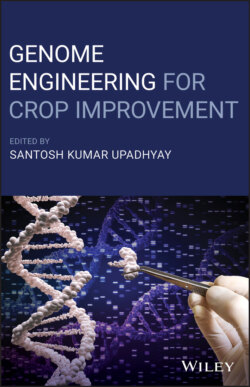Читать книгу Genome Engineering for Crop Improvement - Группа авторов - Страница 52
3.4.1.5 Application of CRISPR/Cas9 for Maize Quality Improvement
ОглавлениеIn Maize (Zea mays) phytic acid constitutes more than 70% of the maize seed. It is believed to be anti‐nutritional as it is not digested by monogastric animals and is also an environmental pollutant. Liang et al. (Liang et al. 2014) have reported targeted knock out of genes involved in phytic acid synthesis (ZmIPK1A, ZmIPK, and ZmMRP4) in Z. mays. Similarly, Zhu et al. (Zhu et al. 2016) demonstrated gene editing of phytoene synthase gene (PSY1) using maize U6 snRNA promoter. PSY1 is involved in carotenoid biosynthesis and its mutant (psy1) results in white kernels and albino seedlings. Among 52 T0 lines obtained by Agrobacterium‐mediated transformation, seven lines were reported to carry the psy1 knockout furthermore, the sequencing analysis undertaken to evaluate the variations generated and mutation efficiency. The results showed that no off‐target sites were edited and stable psy1 mutants were obtained. Feng et al. (Feng et al. 2016) have demonstrated the utility of the CRISPR/Cas9 system in maize by targeting the albino marker gene, Zmzb7 through protoplast system. Knockout of Zmzb7 results in albino plant, with the sgRNA designed to target a region in the eighth exon of Zmzb7 and maize U3 promoter was used for expression. Following Agrobacterium‐mediated transformation of maize embryos, T0 lines were found to show a 31% mutation efficiency. Gene editing tools that can affect multiple gene knockouts are of immense importance to accelerate and achieve efficient crop breeding. For the first time, multiplex genome editing in maize was demonstrated by Qi et al. (Qi et al. 2016) using a tRNA‐RNA processing system. A multiplex editing vector can incorporate a cluster of gRNAs separated by spacers in a polycistron, producing multiple gRNAs from one primary transcript. The study targeted three transcription factor genes (MADS, MYBR, and AP2) for simplex editing and three other genes (RPL, PPR, and IncRNA) for multiplex editing. Increased editing efficiency (up to 100%) was observed for t‐RNA processing based multiplex editing. Current high yielding maize varieties are the result of hybrid maize seed production and the production of hybrid maize requires sterilization to avoid self‐fertilization. Maize thermosensitive genic male‐sterile 5 (ZmTMS5), known to cause male sterility was targeted for genome editing by CRISPR/Cas9 approach (Li et al. 2017). Three gRNAs were used to knockout the gene, with one sgRNA targeting the first exon and the other two sgRNAs targeting the second exon. Mutation efficiency was examined in maize protoplasts using PCR/restriction enzyme assays. Analysis of mutational efficiency revealed that the sgRNA targeting the first exon had no off‐targets whereas the other two sgRNAs had off‐targets in the maize genome. The AUXIN REGULATED GENE INVOLVED IN ORGAN SIZE (ARGOS) gene family are negative regulators of the ethylene response and modulate ethylene signal transduction. Overexpression of ARGOS genes in transgenic maize plants enhances drought tolerance and identification of new allelic variants would be of immense importance in maize breeding programs. Shi et al. (Shi et al. 2017)utilized CRISPR/Cas9 genome editing to create new allelic variants of ARGOS8. Two genome‐edited variants (ARGOS8‐v1 and ARGOS8‐v2) were used for the production of hybrids and evaluated in the field in multi‐location trials. Improved yield under stress condition was observed for the mutant than wild‐type. This study demonstrated the use of CRISPR/Cas9 genome editing method for creating new variants and their application in maize crop improvement.
